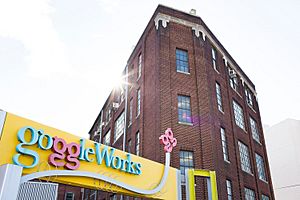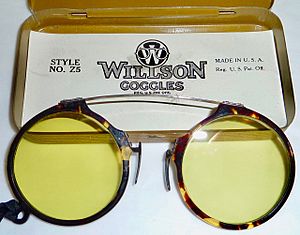GoggleWorks facts for kids
Quick facts for kids |
|
|
Willson, Thomas A. and Co.
|
|
 |
|
| Location | 201 Washington St., Reading, Pennsylvania |
|---|---|
| Built | 1871 |
| Architect | Muhlenberg Brothers |
| Architectural style | Moderne |
| NRHP reference No. | 06000428 |
| Added to NRHP | May 24, 2006 |
 |
|
 |
|
| Established | 2006 |
|---|---|
| Location | 201 Washington St., Reading, Pennsylvania |
| Type | Art Center |
| Visitors | 250,000 annually (free admission) |
| Nearest parking | On-site, rear of building (no charge) |
The GoggleWorks Center for the Arts is a cool place in Reading, Pennsylvania. It's a community center for art and culture. Their main goal is to "transform lives through unique interactions with art." This means they want to help people grow and learn through art.
GoggleWorks is located in an old factory building. This building used to make goggles! Today, it has eight special studios where you can learn different art forms. These include ceramics, glass blowing, metalworking, photography, printmaking, woodworking, and even virtual reality. There are also 35 studios for artists to work in. More than 40 cultural groups also have their main offices here.
You can also find several art galleries at GoggleWorks. There's a movie theater with 130 seats, a restaurant, and a store. The store sells amazing handmade items by over 200 artists. The best part? It's usually free to get in, and parking is free too! The building itself is quite old and important. It was added to the National Register of Historic Places in 2006.
The GoggleWorks Building: A Factory's Story
The building where GoggleWorks is today has a long history. It started as a factory in 1871. A father and son, Gile J. Willson and Dr. Thomas A. Willson, founded the company. It was called Thomas A. Willson & Co. This factory was the first in the world to make special glass for lenses and reading glasses.
The company was located in Reading, Pennsylvania. It became famous for its new ideas in keeping factory workers safe. They are even given credit for starting the whole safety protection industry! Their first big idea was a special lens. This lens blocked dangerous, bright rays from metalworking machines.
In the 1890s, the company grew even more. They started making equipment to protect hearing, breathing, and heads. In 1913, the National Safety Council was created. T.A. Willson & Co. Inc. helped set the rules for safety in factories.
Through the 1920s, they made even more safety gear. This included items for coal miners, soldiers, and pilots. In 1929, the company changed its name to Willson Goggles, Inc. During World War II, Willson Goggles helped the war effort. They made goggles for aviators and oxygen masks for military pilots flying high up.
In 1926, the company changed its name again to Willson Products, Inc. They started making cool sunglasses called Willsonites. Even Miss America contestants wore them in 1938! They also made swim goggles. Famous swimmer Florence Chadwick wore them when she swam across the English Channel in 1950. She was the first woman to swim it both ways!
The company was sold in 1956. But it kept the Willson products name. They continued to be leaders in safety research. They developed new gear for the atomic age and space age. In the 1980s, Willson focused on making new kinds of respirators, gloves, and other protective gear. In 1989, another company called Dalloz bought Willson products. They changed the name to Dalloz Safety in 1997. Sadly, the factory closed its doors in May 2002.
GoggleWorks Center for the Arts: Today's Art Hub
In 2005, three people had a great idea for the old factory building. They were Albert Boscov, Marlin Miller, and Irv Cohen. They wanted to turn it into a big art center. The GoggleWorks officially opened on September 18, 2005.
The GoggleWorks campus is huge, about 145,000 square feet! It's one of the biggest interactive visual art centers in the country. Besides the art studios, it has a 131-seat theater. This theater shows special art house films every day. There's also a café and a store. The store sells art from over 200 artists from all over the country.
Levi Landis became the executive director in 2016. He worked hard to get new money for GoggleWorks. The board also made a plan to improve programs and open new studios. This helped GoggleWorks become financially stable for the first time.
Programs and Fun Activities at GoggleWorks
GoggleWorks is open every day from 9 AM to 9 PM. They always have new art shows to see. They also offer classes each semester in their studios. You can take private workshops or join special programs like "Handcrafted Home." "You Create We Make" is another fun program.
They also have a "Student Ambassador Fellowship" and offer studio rentals. The "After School Arts Program" (ASAP) helps kids learn art after school. Scholarships are available too, so more people can join. They even offer classes for university students. New programs include the A.R.T. program for artists with disabilities and a new restaurant.


